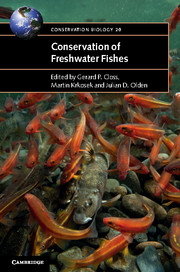Book contents
- Frontmatter
- Contents
- List of contributors
- Preface
- 1 Lost fishes, who is counting? The extent of the threat to freshwater fish biodiversity
- 2 Why are freshwater fish so threatened?
- 3 Climate change effects on freshwater fishes, conservation and management
- 4 Challenges and opportunities for fish conservation in dam-impacted waters
- 5 Chemical pollution
- 6 Multiple stressor effects on freshwater fish: a review and meta-analysis
- 7 Infectious disease and the conservation of freshwater fish
- 8 Non-indigenous fishes and their role in freshwater fish imperilment
- 9 Riparian management and the conservation of stream ecosystems and fishes
- 10 Fragmentation, connectivity and fish species persistence in freshwater ecosystems
- 11 Conservation of migratory fishes in freshwater ecosystems
- 12 Protecting apex predators
- 13 Artificial propagation of freshwater fishes: benefits and risks to recipient ecosystems from stocking, translocation and re-introduction
- 14 Freshwater conservation planning
- 15 Sustainable inland fisheries – perspectives from the recreational, commercial and subsistence sectors from around the globe
- 16 Understanding and conserving genetic diversity in a world dominated by alien introductions and native transfers: the case study of primary and peripheral freshwater fishes in southern Europe
- 17 Maintaining taxonomic skills; the decline of taxonomy – a threat to fish conservation
- 18 Synthesis – what is the future of freshwater fishes?
- Index
- References
1 - Lost fishes, who is counting? The extent of the threat to freshwater fish biodiversity
Published online by Cambridge University Press: 05 December 2015
- Frontmatter
- Contents
- List of contributors
- Preface
- 1 Lost fishes, who is counting? The extent of the threat to freshwater fish biodiversity
- 2 Why are freshwater fish so threatened?
- 3 Climate change effects on freshwater fishes, conservation and management
- 4 Challenges and opportunities for fish conservation in dam-impacted waters
- 5 Chemical pollution
- 6 Multiple stressor effects on freshwater fish: a review and meta-analysis
- 7 Infectious disease and the conservation of freshwater fish
- 8 Non-indigenous fishes and their role in freshwater fish imperilment
- 9 Riparian management and the conservation of stream ecosystems and fishes
- 10 Fragmentation, connectivity and fish species persistence in freshwater ecosystems
- 11 Conservation of migratory fishes in freshwater ecosystems
- 12 Protecting apex predators
- 13 Artificial propagation of freshwater fishes: benefits and risks to recipient ecosystems from stocking, translocation and re-introduction
- 14 Freshwater conservation planning
- 15 Sustainable inland fisheries – perspectives from the recreational, commercial and subsistence sectors from around the globe
- 16 Understanding and conserving genetic diversity in a world dominated by alien introductions and native transfers: the case study of primary and peripheral freshwater fishes in southern Europe
- 17 Maintaining taxonomic skills; the decline of taxonomy – a threat to fish conservation
- 18 Synthesis – what is the future of freshwater fishes?
- Index
- References
Summary
INTRODUCTION
Freshwater rivers, lakes and wetlands are among the most threatened ecosystems on the planet, facing growing pressures from an expanding human population and increased socioeconomic development (Ormerod et al., 2010; Vörösmarty et al., 2010; Carpenter et al., 2011). This pressure on freshwater ecosystems is accompanied by correspondingly high levels of threat to freshwater biodiversity (Dudgeon et al., 2006; WWF, 2010; Thieme et al., 2011; Collen et al., 2014), as is clearly demonstrated by the high species extinction rates and levels of threat recorded on the IUCN Red List of Threatened Species (www.iucnredlist.org), hereafter referred to as the IUCN Red List. North American freshwater bivalves are, for example, notable for having the greatest proportion of extinct species worldwide. In Europe, freshwater species top the IUCN Red List with the highest proportion of threatened species. Remarkable twenty-first-century extinctions such as the baiji (Lipotes vexillifer), the golden toad (Incilius periglenes) and the Alaotra grebe (Tachybaptus rufolavatus), just to name a few, are all freshwater species. However, no-one has yet comprehensively assessed the level of threat and extinction rates for freshwater fishes at the global scale – and it is likely that many fishes are disappearing without record.
The twenty-first century is a critical time for the future of freshwater fishes. Human actions have a serious impact on freshwater ecosystems around the world and the freshwater fish species face ever increasing risks. Unless actions are taken rapidly to reduce the multiple threats facing freshwater fishes, many species will be lost. A sobering example, which serves well to demonstrate the severity of the threat, is the perilous state of the world's sturgeons and paddlefishes (Acipenseriformes). Sturgeon have survived on this Earth for 250 million years, but now face the serious possibility of becoming extinct in this century as a direct result of human activities. Illegal fishing, overfishing, obstructions to migratory routes and pollution has resulted in 23 of the 27 sturgeon species being assessed as threatened on the IUCN Red List. Of these, 17 species are Critically Endangered and four are possibly Extinct, including the Chinese paddlefish (Psephurus gladius), the world's longest freshwater fish for which only two adult specimens (both females) have been recorded since 2002. Human exploitation of freshwater ecosystems and the fishes within them must operate within sustainable limits, and critical sites for freshwater species must be identified and protected before it is too late for many species.
- Type
- Chapter
- Information
- Conservation of Freshwater Fishes , pp. 1 - 36Publisher: Cambridge University PressPrint publication year: 2015
References
- 48
- Cited by



